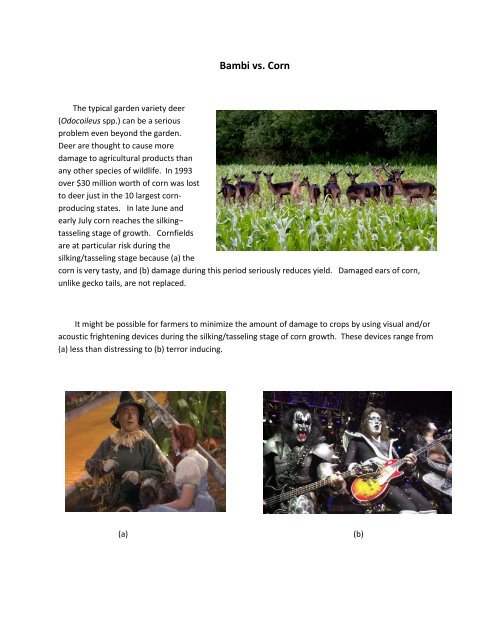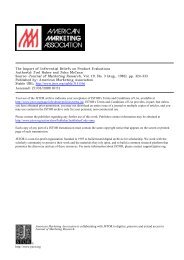Bambi vs Corn.pdf - CAstatistics
Bambi vs Corn.pdf - CAstatistics
Bambi vs Corn.pdf - CAstatistics
Create successful ePaper yourself
Turn your PDF publications into a flip-book with our unique Google optimized e-Paper software.
<strong>Bambi</strong> <strong>vs</strong>. <strong>Corn</strong><br />
The typical garden variety deer<br />
(Odocoileus spp.) can be a serious<br />
problem even beyond the garden.<br />
Deer are thought to cause more<br />
damage to agricultural products than<br />
any other species of wildlife. In 1993<br />
over $30 million worth of corn was lost<br />
to deer just in the 10 largest cornproducing<br />
states. In late June and<br />
early July corn reaches the silking–<br />
tasseling stage of growth. <strong>Corn</strong>fields<br />
are at particular risk during the<br />
silking/tasseling stage because (a) the<br />
corn is very tasty, and (b) damage during this period seriously reduces yield. Damaged ears of corn,<br />
unlike gecko tails, are not replaced.<br />
It might be possible for farmers to minimize the amount of damage to crops by using visual and/or<br />
acoustic frightening devices during the silking/tasseling stage of corn growth. These devices range from<br />
(a) less than distressing to (b) terror inducing.<br />
(a)<br />
(b)
One frightening device under consideration is a bio-acoustic device that would mimic animal<br />
communication signals such as alarm or distress calls. These devices typically consist of an infrared<br />
detection system, which activates an audio component that broadcasts recorded alarm or distress calls.<br />
An alarm call is used to warn others of possible danger; a distress call is emitted when an animal is<br />
physically traumatized or restrained. Researchers have studied the effects of such devices on birds, but<br />
little is known of their effect on mammals. If effective with deer, bio-acoustic alternatives would meet<br />
with public approval and in addition could be used in both rural and urban settings.<br />
You are to design an experiment to test the hypothesis that sound devices can reduce deer<br />
predation on corn. For purposes of this experiment every right-thinking Iowa farmer has volunteered<br />
his acreage for use as test plots; you have complete freedom to choose cornfields for treatment and<br />
control plots. Not only that, every right-thinking Iowa parent has volunteered their teenagers’ boom<br />
boxes (in hopes that you are conducting a multi-year experiment.) These boom boxes came in various<br />
brands, with the Aiwa CD player (model CDC-X217) being the most popular. Infra-red animal-activated<br />
alarm and distress call systems have been purchased from the Charles River Universal Scientific<br />
Technical Yard (CRUSTY) and the corn yield will be measured by yield monitors linked to Global<br />
Positioning Systems on harvesting equipment.<br />
Deer are most active at dusk and dawn, and are frequent feeders at night. They tend to stay close<br />
to wooded areas for safety; farms in Iowa are frequently interspersed with wooded areas.



